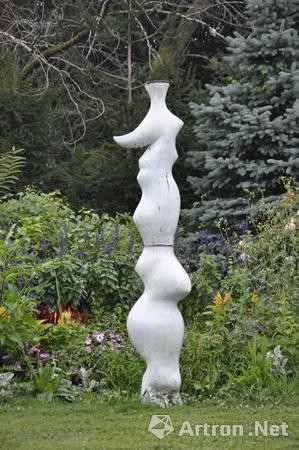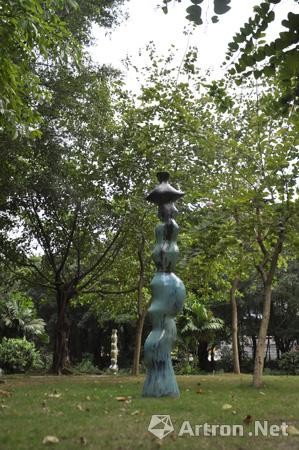
New Mankind·Color 18
Placed in the garden of the Queensboro Community College Museum, Zhang’s statues of New Mankind figures continue a tradition that began with the placement of statues of gods and rulers in temple compounds: a museum is a temple of art—a sacred space for sacred works of art, often worshipped as signs of a god-like artist, a stand-in for God, the ultimate creative, inspired artist. (Thus the “divine Michelangelo.”) In the West, there are two main types of garden, the French formal garden, imposing symmetrical regularity on nature, bringing it under harmonious control, and the English landscape garden, with its irregular asymmetry and beguiling disharmonies, meour world and to takeant to strike the eye rather than appease it. The French garden emerged in the 17th century, the English garden in the early 18th century, but the third kind of garden, the Chinese garden, evolved over three thousand years. It is less formal than the French garden, but not as informal as the English garden. It combines the best features of both—order and freedom—while affording more intimacy with nature than either. The Queensboro Community College Museum Garden resembles it. And it has one feature that the French and English garden lack: the sculptures in them tend to be placed on bases that elevate them above the viewer, as though they were superior to him. The art looks down on them, as though they were inferior to it. Zhang’s sculptures are placed directly on the ground, so that one can approach them as though they were friends, however strange and unfamiliar they may look, making for a more intimate experience of their art, and a deeper understanding of their meaning. We inhabit the same space they do—they don’t stand apart from us—which makes their presence more immediate and direct. We share a common ground with Zhang’s sculptural figures, suggesting we have something in common. I suggest that they become our Doppelgangers or alter egos, more particularly distorting mirrors in which we see our inner absurdness, the fantastic beings we are in our dreams. Zhang’s figurative sculptures have the air of “immediate absurdity” that André Breton said identifies a work as surreal, that is, a synthesis of dream and reality, and as such the mad truth about ourselves. The point is made clearly by Zhang’s Copper # 19, 2004; its weirdly twisted form has what Breton called the “convulsive beauty” characteristic of the Surrealist aesthetic. Copper # 19 is the new abstract Venus, emerging from the green sea of the lawn, her totemic head tilted toward the sky, as though in acknowledgement of her divinity.

New Mankind·Red 06
Zhang’s sculptural figures are generally totemic. One can trace their lineage from early modernist primitivism, inspired by totemic figures from Oceania and Africa, to later modernist primitivism, with its more aesthetically polished, decidedly abstract totemic figures, such as those of Louise Nevelson and Louise Bourgeois. They’re all ambiguously representational and abstract, that is, pictorial and formalist. What distinguishes Zhang’s totemic figures from those of early and later modernist totemic figures is their delightful naturalism: they fit into nature while the early and later totemic figures seem unnatural—more like mechanical constructions, rather than unusual organic phenomena, like Zhang’s Flower #14 and Green #9, both 2004, with their lovely, soft color (sky blue and tropical turquoise) and undulating, erotic forms. They are feminine rather than masculine, like the phallic totemic figures in Nevelson’s An American Tribute to the British People, 1960-65 and Bourgeois’ Quarantania I, 1947-53. Clearly the tide has changed: the aesthetic pendulum has swung back from reductive mechanistic constructivism to expansive naturalistic expressionism. In Zhang’s art living nature has once again become art’s point of departure; the machine proved too anti-life to be followed for long. The figures in Green # 13 and White # 16, both 2004, and White # 03 and Red # 06, both 2005, are all natural growths—spontaneously grow, like flowers and trees, out of the earth. They seem permanently rooted in the earth, rapturous extensions of a flourishing Mother Nature.

New Mankind· Color

New Mankind· Color
Mother Nature is the underlying theme of Zhang’s sculptures. Green # 07, 2005, with her enormous breasts, curved torso, and bulging buttocks, is Mother Nature in all her plenitude. Flower #15, 2004 has the same curvaceous, voluptuous full body. Its curvilinear form is emphatically repeated in the concentric circles, as blue as a clear sky, that adorn its milky white skin. Gesturally intense, they bristle with energy. Red # 22, 2004, Color # 30 and Color # 31, both 2005, bring to mind the many-breasted Diana of Ephesus, an ancient embodiment of the Great Mother. Bodiliness is fundamental to Zhang’s art: her figures tend to be full-bodied, and are often composed of voluminous forms, pot-like or vase-like, usually of different sizes and shapes, piled upon one another, and often painted in bold colors, giving them an air of primitive elegance. They remind us that the first ceramicists were potters, making rudimentary containers for food and drink, the basic necessities of life—as basic as the containers. Zhang’s sculptures are stoneware, traditionally used to store and preserve them forever. The concentric rows of bold blue circles that mark the New Mankind· Color 34
curvilinear sections of Flower # 23, 2005 suggest the abundance they are able to contain. Again and again we see different sized containers, all grandly and gracefully curved, piled upon each other, often forming a radiant abstract figure, proudly standing upright, its vitality emanating in its color: Purple # 26, Green #33, and Green # 34, all 2005 are striking examples.

New Mankind· Color 30
The vessels are womb-like, confirming their feminine character. Purple # 26, 2005 is conspicuously female, a powerful domineering woman, as her forcefully projecting breasts and hands—they’re ingeniously integrated—suggest. Purple is the color of royalty, and she is royal--the Queen of the garden, indeed, of all she surveys. The slender female figure Red # 12, 2004 seems to be dancing like a delirious maenad. There is a Dionysian excitement and energy in all of Zhang’s female figures. There is nothing Dionysian about Green # 8, 2004, Copper # 20, 2005, which I take to be male Red Guard figures, as their penis-like Pinocchio noses, implying they’re liars, suggests. They’re rather colorless, dull, static figures compared to Zhang’s colorful, joyous, dynamic female figures.

New Mankind·Copper 20
Zhang’s robust, colorful female figures are not only symbols of Mother Nature at different seasons—the snowy white figures evoke Winter, the pale green figures suggest Spring, the purple figures symbolize full-blossomed Summer, the figures with autumnal colors evoke Fall--they are also, in principle if not in form, dragon ladies, that is, representations of Zhang’s character and psyche. The Chinese dragon is fundamentally different from the Christian dragon. Simply put, the former is good, the latter is bad—a symbol of evil, the devilish dragon that St. George slew. As the scholar Ernest Ingersoll writes, “Chinese dragons traditionally symbolize potent and auspicious powers, particularly over water, rainfall, hurricane, and floods.” More broadly, the dragon is “a symbol of power, strength, and good luck,” which is why the Emperor of China used it as “a symbol of his imperial power and strength.” The Chinese dragon may be aggressive, but its aggression is in the service of the ego. Thus Zhang, a woman with a strong ego, aggressively making good art, is a “dragon lady.” “The nine dragons stand proud in their own aura,” Zhang has said, referring to the fifth and last section of the New Mankind Series. So does Zhang, who stands proud in the aura of her dragon lady sculptures, each a sort of good luck charm in nature, indicating that it is lucky to be part of nature.
There is Chinese proverb that says “Hoping one’s son will become a dragon.” It is worth noting that the sons of Communist China—the Red Guards--are dumb and brutal: they mindlessly toe the party line. Zhang’s achievement—her vigorous creativity--suggests that there ought to be a proverb saying “Hoping one’s daughter will become a dragon.” The dragon lady Zhang is independent, strong, nurturing. She serves expressive nature, full of life, rather serves emotionally stifling Communism, with its deadening dogmatism. Her series of sculptural figures have more to do with the New Womankind than the New Mankind. The revised proverb is as needed in America as in China.
note
(1)Liz Rhoades, “Duality Exhibit Features Bronze and Ceramics,” Queens Chronicle, October 6, 2011
(2)Quoted in Stephen Bann, ed., The Tradition of Constructivism (New York: Viking, 1974), 26
(3)Ibid., 18
(4)Ibid., xxiii
Copyright Reserved 2000-2025 雅昌艺术网 版权所有
增值电信业务经营许可证(粤)B2-20030053广播电视制作经营许可证(粤)字第717号企业法人营业执照
 京公网安备 11011302000792号粤ICP备17056390号-4信息网络传播视听节目许可证1909402号互联网域名注册证书中国互联网举报中心
京公网安备 11011302000792号粤ICP备17056390号-4信息网络传播视听节目许可证1909402号互联网域名注册证书中国互联网举报中心
网络文化经营许可证粤网文[2018]3670-1221号网络出版服务许可证(总)网出证(粤)字第021号出版物经营许可证可信网站验证服务证书2012040503023850号